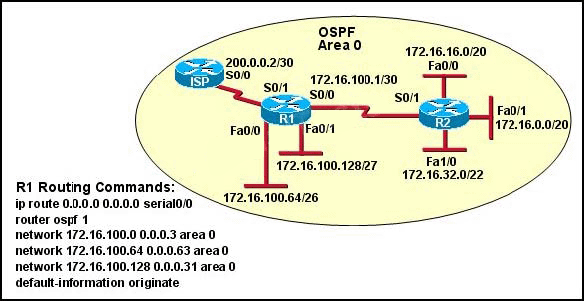Refer to the exhibit.

Assume that all router interfaces are operational and correctly configured. In addition, assume that OSPF has been correctly configured on router R2. How will the default route configured on R1 affect the operation of R2?
A . Any packet destined for a network that is not directly connected to router R1 will be dropped.
B . Any packet destined for a network that is not directly connected to router R2 will be dropped immediately.
C . Any packet destined for a network that is not directly connected to router R2 will be dropped immediately because of the lack of a gateway on R1.
D . The networks directly connected to router R2 will not be able to communicate with the 172.16.100.0, 172.16.100.128, and 172.16.100.64 subnetworks.
E . Any packet destined for a network that is not referenced in the routing table of router R2 will be directed to R1. R1 will then send that packet back to R2 and a routing loop will occur.
Answer: E
Explanation:First, notice that the more-specific routes will always be favored over less-specific routes regardless of the administrative distance set for a protocol. In this case, because we use OSPF for three networks (172.16.100.0 0.0.0.3, 172.16.100.64 0.0.0.63, 172.16.100.128 0.0.0.31) so the packets destined for these networks will not be affected by the default route. The default route configured on R1 "ip route 0.0.0.0 0.0.0.0 serial0/0 will send any packet whose destination network is not referenced in the routing table of router R1 to R2, it doesn’t drop anything so answers A, B and C are not correct. D is not correct too because these routes are declared in R1 and the question says that "OSPF has been correctly configured on router R2, so network directly connected to router R2 can communicate with those three subnetworks. As said above, the default route configured on R1 will send any packet destined for a network that is not referenced in its routing table to R2; R2 in turn sends it to R1 because it is the only way and a routing loop will occur.

Leave a Reply